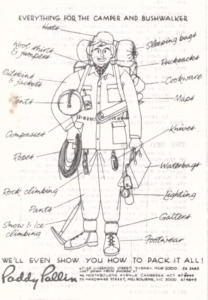This post follows a 3 part series beginning with Part 1: The Risks, where we looked at weeds, fungus or bugs in the bush, and terms like Biosecurity. In Part 2: The Solutions we looked at awareness, the NSW Biosecurity Act 2015, our responsibility for our environment as well as actions we can take now. In this article, we look at the club level and teaching others.
So is every bushwalker scrubbing their car tires, or picking seeds from their clothing and depositing them in a ziplock bag? Probably not, so how can we influence our walkers to be biosecure?
Luckily, not every walk requires every solution we have mentioned. One thing Sarah discusses is bushwalkers being ‘in sync’ with the area we are walking in.
This means knowing your walk – something our club leaders are experts on already.
“Educating yourself on the potential environmental impacts you might have within a park and discussing the issues and the ways you can moderate your impact helps to make minimum impact bushwalking strategies more commonplace.”
Some interesting tips include:
- A leader’s box in the car – one with a diluted metho spray bottle and a brush – that can be pulled out before or after a walk will ensure that every walker understands what is best practice.
- When emailing and organising the walk, include any biosecurity risks and solutions you would like walkers to be aware about.
- Discuss signage board alerts during the walk. Identify and report possible pests or species by taking a photo and GPS co-ordinates.
- Identify potential risks and walker gear in your group such as open weave cotton t-shirts.

“Luckily, brushing down your boots is a very effective way of stopping weeds spreading! We are hoping to cultivate a practice of brushing down boots to remove soil and seeds before entering a walking trail and when exiting a trail. Our end objective is to install brush-down bays at trailheads, starting with key trails in Kosciuszko NP.”
Lastly, we can get involved. As clubs, we can have our say on Minimum Impact and Biosecurity, engage in weed eradication volunteering, and discuss tips and tricks to make cleaning easy.
Some ideas to facilitate discussion are:
- Include Biosecurity in Information Nights and Basic Skills Workshops
- Review the club’s Minimum Impact or Bushwalker’s Code and strategies
- Add a section on the proposals, walk programs and walk submissions guidelines to include Biosecurity measures
- Have an information night to raise awareness, using Sarah Fulcher’s power point presentation.
“Discuss some of the issues raised in this article – what people wear, how they collect and dispose of seeds from their socks or tent, boot cleaning and personal hygiene with a view to making small changes in behavior. A walk’s leader with a ‘clean box’ who is mindful about the area being walked in can have a major influence on the behavior of a group.”
Read “Are you a Biosecure Bushwalker?” for further information, links and articles.
Use this presentation for your club: Sharon Fulcher: How can we ‘Leave no Trace’ when bushwalking?
See Arrive Clean, Leave Clean for identifying biosecurity threats, cleaning guides, hygiene checklists and kits.
Learn more about invasive species.
Notes, slides and content courtesy of Sharon Fulcher.
Photos under Creative Commons Licence on Pexel
Hand photo by Marcos Luiz Photograph on Unsplash














